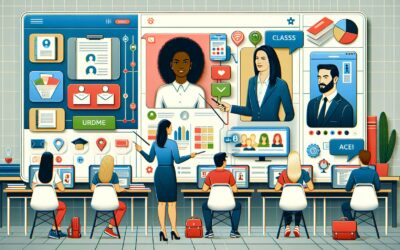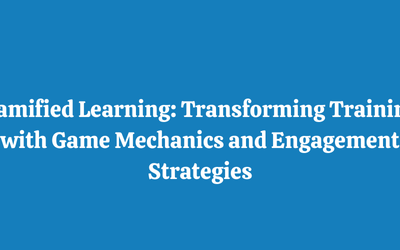Gamification
Gamification
If there was a prize for an Elearning concept, it would probably be intuitive learning using gamification. Consequently, it is like the proverbial set of blind men feeling different parts of an elephant. Then arriving at their own vision of what the animal looked like. Similarly, gamification means many different things to many different people.
We present below some of the common ways to visualise intuitive learning in Gamification, in the context of E-learning.
Animation and Interaction
The most basic E-learning intervention we can visualise is as some sort of a Powerpoint Plus or Video intervention. Similarly here also a series of screens with relevant text with a voiceover handles the subject through the screen.
The most common understanding of Gamification is that of an E-learning interventions. It will go beyond this basic format of Powerpoint Plus or Video. There are primarily two vectors on which this happens:
- Animation – The onscreen text (OST) of the basic intervention replaces or embellishes static examples, figures, infographics. It illustrates the subject in a manner. Hence it becomes more appealing to the learner. As the quality of the intervention is enhanced, static examples and figures can give way to animated examples, figures and infographics. It seeks to hold the learner’s attention
- Interaction – Even today, it is the most common format of delivering E-learning, even by established names in the E-learning business. It is through one-sided Videos and Powerpoint Plus files, with or without examples, figures and infographics, static or animated. There is high risk in such interventions. The learner can lose interest as he is merely a spectator. To overcome this limitation, creators of E-learning interventions are increasingly designing them in a different manner. The learner necessarily has to interact with it for it to keep progressing. These interactions often take the shape of solving a problem. We approach it through a quiz, or a drag-and-drop exercise, or role-play or typing in a free format response or even recording a video. For the learner, it becomes a bit like participating in a “game”, hence the reference to gamification in this context.
Gamified Environment
Many organisations make an effort to harness the inherent desire of humans to participate in challenges and excel and outshine others.They are looking for achieving superior learning outcomes as well as business goals. This normally manifests itself in the form of a scorecard, or leaderboard. They access it to motivate participating employees to move up on it.
Organisations are required to identify and reward desirable behaviour and actions while penalising undesirable behaviour and actions that are detrimental to the business. The scope of this gamification varies from organisation to organisation and its ability to recognise desirable and undesirable behaviour and actions and ability to track them in a reasonably transparent manner. Outcomes are tied to the financial rewards the company offers to employees or could be run as a parallel process leading to non-financial rewards and recognition in the form of stars and badges, etc.
Though often larger than E-learning, it constitutes an integral part of the effort with the organisational Learning Management System (LMS) the backbone which monitors, tracks and publishes scorecards and performance.
Gamified, glorious “skin”
This form of gamification can also be referred to as a gamified “skin” of an E-learning intervention. Here, some E-learning creators try to go high on the creative quotient in order to impart the feeling of a “game” to an intervention. For example, an intervention could be created in the form of raiding a castle, or climbing a mountain, or travelling to outer space, or anything else they believe will appeal to learners.
This format will deliver key learning messages. In a regular E-learning intervention, with or without figures, examples and infographics, it is either static or animated. The concept is to move towards the stated goal. It could be summiting a peak or landing on Mars. Periodically the learner will be asked to answer questions based on the learning provided so far. Once he answers correctly he will move forward. The learner, many a time may be engaged in the glorious activity of rescuing the princess. Basically, he is constantly brought back to reality with the business questions he needs to keep answering.
Learning with preset Goals
We should note that moving forward with intuitive learning using gamification on the mission neither requires the learner to demonstrate any skill or learning relevant to that task, either climbing or space travelling, nor does it bear any connection to the learning goal or subject or industry or function. The learner might be made to climb a mountain, or travel to outer space or dive down to the depths of the ocean or anything else, for the same learning. He will be delivered the same learning messages and will need to solve the same problems for moving from one place or level to the next.
In this format, the “skin” of the intervention becomes both key and irrelevant. Since it is key that needs to be attractive so that it can engage learners. Similarly, it is also immaterial because it mostly bears no relevance to the subject at hand.
Gamification – Pure Game, Incidental Learning
This perhaps remains the Holy Grail of gamified E-learning.
According to some, this is the highest, and most desirable, form of gamification. The intervention designs it as a “pure” game. Without artificial props like answering business questions to move to the next level. It delivers an enjoyable experience to the learner. It is like a game which he wilfully participates in, while subliminally delivering the learning messages. For example, in the game of Monopoly, we try to achieve the goals set out in the game. The process of doing so delivers messages like value of property, strategy, consolidation, etc. to participants. And we believe that because these are not learning goals, but merely byproducts of an enjoyable activity, they become ingrained in the participant.
Gamification – Designing of the concept
Intuitive learning using gamification designing is an important element. And again, we design a wide range of games. Contrary to perception, these games don’t necessarily need to be complex. Some simple examples:
- A “Memory and Matching” game requires participants to match cards in two decks kept face downwards. When children play this game, there could be a matching of an animal on one side with its young on the other. They pick a card from each deck. If they match they take it out and pick again, else they keep the cards back in place. The cues are suitably modified to reflect the business catered to in the E-learning situation.
- A “Crossword” quiz with cues and answers relevant to the business and learning
There is a challenge with this form of gamification. It might seem too much like fun. While we believe fun is good, we don’t want to permit it on our watch. Although, it leads to better outcomes. Only mature, confident organisations, who are not under constant pressure to prove outcomes, might be in a position to deploy these.
Gamification – Conclusion
Whichever format of gamified E-learning your organisation chooses, it is upto us to utilise the concepts. Industries and learning organisations use this on an extensive basis. Salesforce is the most important business process that can utilise gamification to reap the most profit out of it. As gamification takes very little time for interaction, salesforce can access it on the go.
Learn More
Our News
- AI
- Animations
- Articulate
- Articulate 360
- Articulate Engage
- Articulate Live
- Articulate Presenter
- Articulate Quizmaker
- Articulate Replay
- Articulate Review
- Articulate Storyline
- Articulate Storyline 3
- Articulate Studio
- bite sized learning
- Characters
- Content Library
- Corporate Communication
- E-Learning
- e-Learning Authoring Tools
- Employee Engagement
- Game-Based Learning
- Gamification
- Gamiflexer
- Go Sales
- Healthcare
- Instructional Design
- Interactivity
- Knowledge Transfer
- L&D Trends
- Learning
- Learning & Development
- Learning Experience platform
- Learning Management System
- LMS
- LXP
- Microlearning
- mLearning
- Mobile Learning
- Nugget Learning
- Online Training
- Peek
- Performance Support
- Preso
- Quiz and Assessment Platform
- Replay 360
- Rise
- SCORM
- Screen Capture
- Software
- Storyline 360
- Studio 360
- Training Management
- Trainings
- Uncategorized








